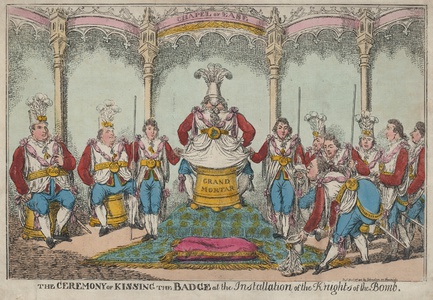| Method | Etching with original hand colouring |
| Artist | Charles Williams |
| Published | Pubd. Novr. 1st 1816 by Johnston, 98 Cheapside |
| Dimensions | Image 225 x 330 mm, Plate 245 x 345 mm, Sheet 278 x 350 mm |
| Notes |
A scatological satire of the Prince Regent's involvement both in the restructuring of the Order of the Bath, and the erection of the Cadiz memorial, etched by Williams for inclusion in the twelfth volume of the popular magazine 'The Scourge, or monthly expositor, of imposture and folly.' The scene farcically presents the investiture of members to a new Knightly Order, the Order of the Bomb, named for the colossal French mortar that had been abandoned following the breaking of the siege of Cadiz. The Spanish, in thanks, had presented the weapon to the Prince Regent in honour of Wellington's victory at the Battle of Salamanca. The Prince arranged for the creation of a mount for the mortar, featuring a dragon-like Geryon, the monster from classical myth slain beyond the Pillars of Hercules by the hero himself. Geryon, in addition to his role in the foundation myths of Gades (Cadiz) was also, following Dante, a popular allegory for Fraud, an appropriate mount for a cannon that was created by the French forces to inspire terror by its sheer size and noise, rather than for any particular efficacy as a weapon of war. Unfortunately for the Regent, the common usage at the time for any cannon or mortar was 'bomb,' pronounced homophonically in the French fashion as 'bum.' Considering the Regent's avoirdupois, popular satires and puns immediately labelled the monument the 'Prince Regent's Bomb,' with all of the obvious jokes about its size, shape, noise, wind, range, and smell. In the current scene, the Regent, in the regalia of the Great Master of the order, sits at centre with his back to the viewer, atop a chamber pot entitled 'Grand Mortar.' His royal skirts are held up on either side by a Companion, while the newly invested Knights Commander, wearing belted surcoats and flower-pot caps crested with the three white feathers of the Prince of Wales, sit alongside upon golden mortars of their own. A Knight to the right of the scene, having doffed his cap, purses his lips in preparation to kiss the badge of the order, which hangs low on the Prince's back. The ritual takes place within a gothic-porticoed 'Chapel of Ease.' Charles Williams (active 1796-1830) was a British printmaker. In particular, he was a prolific etcher of satires to his own or others' designs. Almost all of his plates are unsigned. In later years he worked for different publishers simultaneously, including Fores, E. Walker, members of the Knight family, and Tegg (from 1807). BM Satires 12811 Condition: Vertical and horizontal folds, as issued. Trimmed to platemark on right margin. Minor time toning and creasing to margins. Old adhesive tape to top and bottom of sheet on verso. |
| Framing | unmounted |
| Price | £275.00 |
| Stock ID | 53359 |

